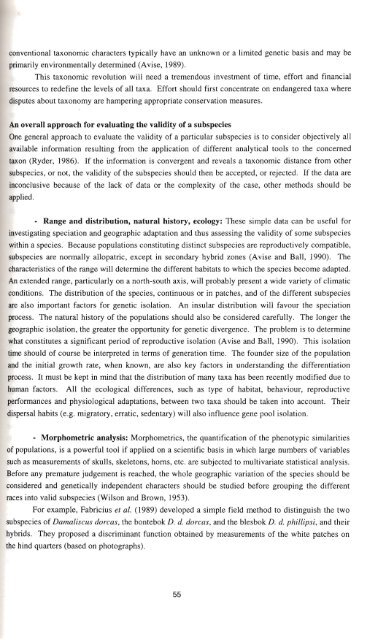CONSERVATION OF ARABIAN GAZELLES - Nwrc.gov.sa
CONSERVATION OF ARABIAN GAZELLES - Nwrc.gov.sa
CONSERVATION OF ARABIAN GAZELLES - Nwrc.gov.sa
Create successful ePaper yourself
Turn your PDF publications into a flip-book with our unique Google optimized e-Paper software.
conventional taxonomic characters typically have an unknown or a limited genetic basis and may be<br />
primarily environmentally determined (A vise, 1989).<br />
This taxonomic revolution will need a tremendous investment of time, effort and financial<br />
resources to redefine the levels of all taxa. Effort should first concentrate on endangered taxa where<br />
disputes about taxonomy are hampering appropriate conservation measures.<br />
An overall approach for evaluating the validity of a subspecies<br />
One general approach to evaluate the validity of a particular subspecies is to consider objectively all<br />
available information resulting from the application of different analytical tools to the concerned<br />
taxon (Ryder, 1986). If the information is convergent and reveals a taxonomic distance from other<br />
subspecies, or not, the validity of the subspecies should then be accepted, or rejected. If the data are<br />
inconclusive because of the lack of data or the complexity of the case, other methods should be<br />
applied.<br />
- Range and distribution, natural history, ecology: These simple data can be useful for<br />
investigating speciation and geographic adaptation and thus assessing the validity of some subspecies<br />
within a species. Because populations constituting distinct subspecies are reproductively compatible,<br />
subspecies are normally allopatric, except in secondary hybrid zones (A vise and Ball, 1990). The<br />
characteristics of the range will determine the different habitats to which the species become adapted.<br />
An extended range, particularly on a north-south axis, will probably present a wide variety of climatic<br />
conditions. The distribution of the species, continuous or in patches, and of the different subspecies<br />
are also important factors for genetic isolation. An insular distribution will favour the speciation<br />
process. The natural history of the populations should also be considered carefully. The longer the<br />
geographic isolation, the greater the opportunity for genetic divergence. The problem is to determine<br />
what constitutes a significant period of reproductive isolation (Avise and Ball, 1990). This isolation<br />
time should of course be interpreted in terms of generation time. The founder size of the population<br />
and the initial growth rate, when known, are also key factors in understanding the differentiation<br />
process. It must be kept in mind that the distribution of many taxa has been recently modified due to<br />
human factors . All the ecological differences, such as type of habitat, behaviour, reproductive<br />
performances and physiological adaptations, between two taxa should be taken into account. Their<br />
disper<strong>sa</strong>l habits (e.g. migratory, erratic, sedentary) will also influence gene pool isolation.<br />
- Morphometric analysis: Morphometrics, the quantification of the phenotypic similarities<br />
of popUlations, is a powerful tool if applied on a scientific basis in which large numbers of variables<br />
such as measurements of skulls, skeletons, horns, etc. are subjected to multivariate statistical analysis.<br />
Before any premature judgement is reached, the whole geographic variation of the species should be<br />
considered and genetically independent characters should be studied before grouping the different<br />
races into valid subspecies (Wilson and Brown, 1953).<br />
For example, Fabricius et al. (1989) developed a simple field method to distinguish the two<br />
subspecies of Damaliscus dorcas, the bontebok D. d. dorcas, and the blesbok D. d. phillipsi, and their<br />
hybrids. They proposed a discriminant function obtained by measurements of the white patches on<br />
the hind quarters (based on photographs).<br />
55
















